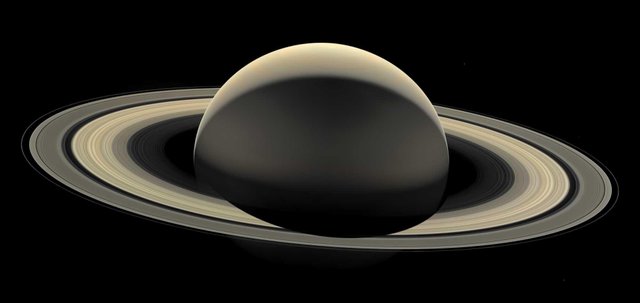Maybe we owe our existence to Saturn
Why is this gas giant the best planet.Saturn is the favorite planet of many scientists and astronomers.

Its golden color, it owes its atmosphere, mainly consisting of hydrogen and helium. But, in the atmosphere there are also small amounts of ammonia, phosphine, water vapor, and hydrocarbons. It is a collection of rich elements that make scientists believe that Saturn is one of the first planets, if not the first, to form in our solar system. Together with Jupiter, Saturn absorbs most of the hydrogen and helium left over from the big bang, clouds that almost disappear when other planets in our system begin to form.The planet's body is not only beauty, but also ancient times which consisted of elements born at the beginning of the appearance of our universe.
This gas giant is so large that it can accommodate 760 planets like our Earth. And the sparkling ring can boast more than 250,000 km - more than twice the diameter of Jupiter. They spun with dizzying speed in the deep darkness of the solar system, sparkling like the faces of precious stones, with their shiny bodies measuring less than 100 meters, which consisted mostly of water ice.This is a layer of ice that reminds us how much water is actually outside of Earth, how many possibilities our lives have not run out near our homes. Other planets behind the asteroid belt also have thin and dull rings around them, but none looks fancy like Saturn. In fact, Saturn's rings are so complicated that they contain a sample of rings from all the other planets that are joined together.

Scientists are still arguing about how and when Saturn's rings were formed. Some believe that the rings are the remains of a destroyed comet, asteroid or moon. Some studies even show that they can be made from dead dwarf planets. It is also unknown whether they are as old as the planet itself (4.5 billion years), or they appeared only a few hundred million years ago.NASA sent four probes for research. Unfortunately, Saturn's rings will disappear around 50 million years, either because they will disappear, or because they will be absorbed by the planet.

Inside Saturn's soft-looking body, in fact, there is a thick layer of hot gases that suffocate with pressure that can destroy any spaceship that will try to investigate the extent of this gas giant. And the hexagonal storm that rages on the planet's North Pole is so large that it matches the size of six Earths, and the wind reaches thousands of kilometers per hour. Over the years, this giant storm has mysteriously changed color, probably due to changes in seasons.
However, apart from the hostile environment of Saturn, however, we must thank him for his life on Earth. Together with Jupiter, giant Saturn helps stabilize the solar system and prevents asteroid invasions and other celestial bodies that attack inner planets, including our Earth. With giant planets, collisions in the formation of the solar system occur from about 10 to 100 million years.And without them it could last for billions of years after the formation of our planet. These consequences will not only damage the surface of our planet, but also destroy the atmosphere, which will sharply reduce the possibility of life's emergence and development. Gas giants use their masses to get rid of asteroids and other bodies from the solar system, change their trajectories, or absorb them, pulling them to themselves.
the same gravitational influences from Saturn and Jupiter might push Neptune and Uranus outside the Solar System.
We are also fortunate that the giant is where they are. If Saturn is only 10% closer to us than he, he will have an impact on Earth's orbit, increasing tens of millions of kilometers. This orbit will be outside the habitable zone, endangering the possibility that the planet will be in liquid water. Now the earth is almost perfectly circular orbit, which varies by only 8 million kilometers throughout the year.
It's safe to say that life on Earth also came about thanks to Saturn.